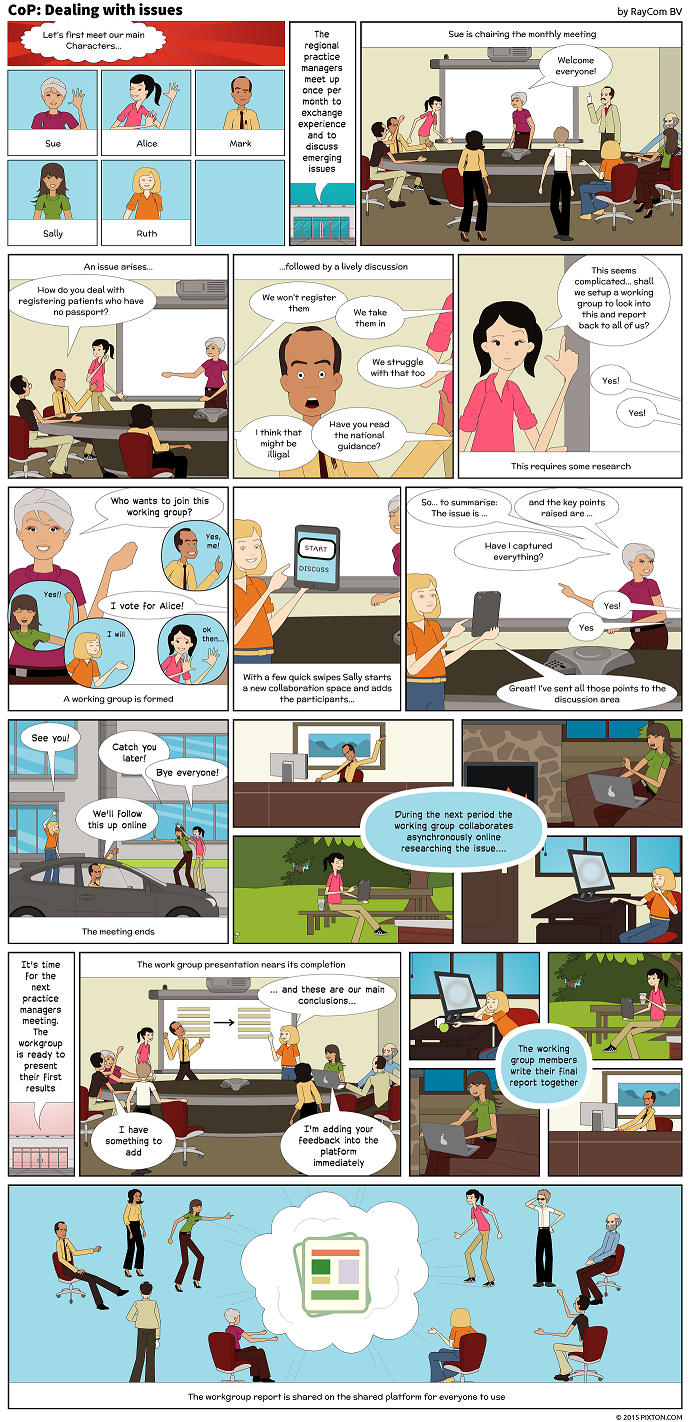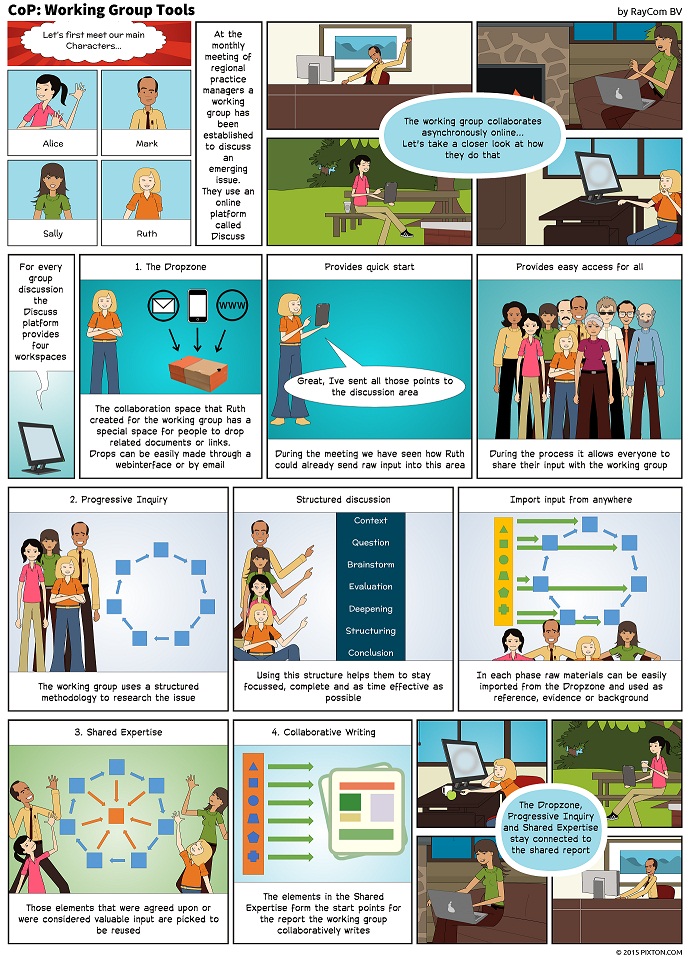Confer provides online collaboration spaces for working groups that can be used both synchronously as well as asynchronously. Confer supports your group to work collaboratively on a task or project; helping to keep the work focused and flowing, recording the discussions and reasoning along the way and producing a final summary output that can become the first draft of your report or recommendations. This is achieved through following the group following 3 steps (built upon the progressive inquiry model) as supported by Confer (with discussions and progress recorded):
Define the problem to be investigated and its context. What, where, when and for whom?
Brainstorm to identify important issues and fill knowledge gaps.
Develop and describe solutions and agree on a recommendation.
Features
- Easy collection of a working group’s ideas and discussions in one place
- Structuring (scaffolding) of collaborative groupwork (based on progressive inquiry model)
- Contextualised discussion supported throughout - discussion tied to the items being discussed
- Ability to easily share progress of groupwork with wider stakeholder groups and senior managers
- Option for others (stakeholders, managers) to easily send in ideas or comments to the groupwork space
- History and development of ideas easily tracked and reported
- Can be used to facilitate and record groupwork discussions in face-to-face meetings
- Export end results into Living Documents [link:T-04] (collaborative writing tool) as the first draft of formal report
Uses
- Distributed team working on a project and needing to structure, discuss, track and share their work. Confer was piloted with a range of distributed teams working on projects including the design of a new service for a General Practice Federation, the communications plan for a national healthcare team and the development of a new training programme by a regional team.
- Supporting and recording the discussion of a project/idea within a face-to-face meeting. Allows all present to put ideas into the Confer workgroup (from their own laptop) and see (and directly interact with) the ongoing discussion/work in the live Confer workgroup on a projected screen.
- Problem based learning. Confer can be used by a group of students following a problem based learning (PBL) curriculum. They can share, develop and collaborate on the problem within Confer, record the progress and decision points and produce a collaborative report.
- Supporting individual project development with a mentor. An individual uses Confer to develop their project (exploring the problem and proposing solutions). Their mentor is able to dip into Confer to monitor the project development and provide support/guidance where needed.
Tech specs
- Confer is a web application that consists of an HTML5 front end that was built using AngularJS and a back end that was built on a MENS stack, consisting of MongoDB, ExpressJS, NodeJS and Socket.io. The back end consists of three parts:
- a RESTful API that handles stateless requests from the user interface;
- a Socket server that handles all synchronous collaboration requests;
- a node based mail server that handles incoming e-mail messages.
- Confer is currently designed to be a web app, which displays best on a desktop computer or tablet.
- Confer requires internet connectivity. It is is not possible to work offline.
- It supports ‘real-time’ synchronous editing and working within the workgroups
- The source code can be found on the Learning Layers Github server https://github.com/learning-layers/confer
The Story
Confer was co-designed with healthcare professionals working in Primary Care in the UK. The key groups involved in the co-design and piloting of Confer were cross-organisational networks of Practice Managers from different General Practices. General Practices in the UK are independent organisations who deliver Primary Care services to their registered patients - they are your family doctors. General Practices tend to be owned by the ‘partner GPs’ (doctors) and employ other salaried clinical and administrative staff, including a Practice Manager. The Practice Manager networks had been set up by the Practice Managers and General Practices themselves in order to support the General Practices in working together to address common problems in their region, support joined-up healthcare, share workloads and explore potential efficiency savings for example through the development of shared services. The Practice Managers network brings the Practice Managers together to work on collaborative projects in these areas.
Learning Layers adopted an overall design based research (DBR) approach [link:M-08] to the design and development of Confer. This involved bringing together researchers, developers and practitioners (healthcare professionals) to iteratively explore how the networks worked and learned, design, field-test, evaluate and re-design the tools to support this working and learning practice. More information on the DBR approaches used can be found in the co-design [link:M-03] and participatory patterns design [link:M-05] sections of this website, with further detail about the co-design of Confer in [1] and [2].
The particular pain points that were identified, in the earlier stages of the work, were the difficulties that the network members had in keeping their project work moving in-between their monthly face-to-face meetings and also some issues around how to include wider stakeholder groups into their work at earlier stages. Drawing on educational theories (in particular the progressive inquiry model [3] ) and input from the healthcare professionals themselves, a set of storyboards were designed to help guide the development of the Confer tool.


Based on these initial designs, Confer was developed and iteratively field-tested and refined with a small set of healthcare professionals, before being piloted with 1 healthcare network and 2 healthcare teams in the final year of the project.
Research
Confer is based on theories to support [Progressive Inquiry and Knowledge Building](/scenarios/progressive-inquiry). Confer has been piloted with three groups, a cross-organisational network of Project Managers, a small regional team developing and delivering quality improvement training to healthcare professionals and a national team developing and implementing strategies for technology enhanced learning in healthcare. The pilots took place over a 5 month period in 2016 and the evaluation focused on the impact that the tools had on the working and learning practices in the groups. Observed changes in practices (reported as beneficial by the participants) included the use of Confer within face-to-face meetings to help structure and record discussion and the use of Confer’s public view and email-in (dropzone) functionality to engage wider stakeholder groups in project work at an earlier stage. These two findings matched design patterns (Tapas Tour and Early, easy engagement) that had been developed during the participatory patterns design process; therefore showing that this design approach has been a successful way of developing tools to support real user needs. Further detail on the design patterns and the evidence found for their acceptance can be found in section 3.2 of the Report of Summative Evaluation in the Healthcare Pilots, [4].
Additionally healthcare pilot participants and stakeholders have identified potential new use cases for Confer, based on their experience of using it or seeing it demonstrated. These include using Confer to support student groups engaged in problem-based learning (proposed by healthcare stakeholders who visited the Learning Layers stand at AMEE) and using Confer to support individuals undertaking quality improvement projects (providing them with a structure to follow) and enabling their mentors to monitor their progress and provide guidance when needed (proposed by a healthcare participant in the pilot studies). These opportunities are being explored and the developers and researchers would also be interested in discussions with others who have an interest in using and further developing Confer in research and development projects.
Contact
References
- Y. Mor, J. Cook, P. Santos, T. Treasure-Jones, R. Elferink, D. Holley, and J. Griffin, “Patterns of practice and design: Towards an agile methodology for educational design research,” in Design for Teaching and Learning in a Networked World, Springer, 2015, pp. 605–608.
- J. Cook, Y. Mor, P. Santos, T. Treasure-Jones, R. Elferink, and M. Kerr, “Using the participatory patterns design (PPD) methodology to co-design groupware: Confer a tool for workplace informal learning,” in EdMedia 2016, Vancouver, BC, Canada, 26-30 June, 2016 [Online]. Available at: http://eprints.uwe.ac.uk/27653
- H. Muukkonen, K. Hakkarainen, and M. Lakkala, “Collaborative technology for facilitating progressive inquiry: Future learning environment tools,” in Proceedings of the 1999 conference on Computer support for collaborative learning, 1999, p. 51.
- R. Dewey, M. Geiger, M. Kerr, R. Maier, M. Manhart, P. Santos Rodriguez, C. Sarigianni, and T. Treasure-Jones, “Report of Summative Evaluation in the Healthcare Pilots,” pp. under review, 2016 [Online]. Available at: Link
Links to other sections
Healthcare Distributed Teams in Healthcare
Healthcare Teamwork in and between General Practices
Knowledge Sharing & Protection in Networks of Organizations
Knowledge Appropriation in Informal Workplace Learning
Progressive Inquiry and Knowledge Building
Participatory Patterns Workshop
The healthcare changed practices paper (under development)
Report of Summative Evaluation in the Healthcare Pilots, [4]